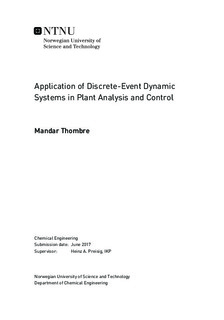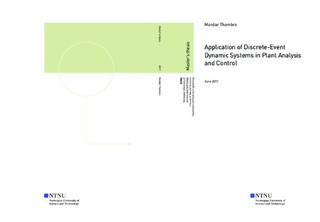| dc.description.abstract | Chemical process plants typically follows continuous dynamics. However, for various plant operations like start-up, shut-down and maintaining safe operability, it is necessary to obtain information about the discrete state of the system under consideration. This is achieved by observing the continuous system with discrete sensors (temperature sensors, level sensors, etc.) which emit a signal when a process variable crosses a certain value, as opposed to at constant time intervals. This results in a quantized system where the state-space is discretized by these discrete sensors. Each partition of this discretized state-space - known as a hypercube - corresponds to a different discrete state of the system. An event in this context is when the system makes a transition from one discrete state to another adjacent discrete state. This quantized system can thus be said to be a discrete-event dynamic system (DEDS). The DEDS that is abstracted from a plant with continuous
dynamics can be modelled as an automaton. This thesis broadly covers the modelling of such DEDS and two related aspects where these models can be used - hazard and operability (HAZOP) analysis and supervisory control in plants.
Conventional HAZOP techniques are not reliable for identifying low-frequency,
high-risk hazards caused by multiple simultaneous failures. The total number of
all possible failure overlaps is very high, making it is infeasible to analyse them using conventional techniques. The analysis can be done computationally using the DEDS model of the plant. HAZOP involves defining a region of safe operation within the entire state-space. The plant automaton and this defined safe operability region can be combined to identify regions in the state-space where the state has the possibility to go out of safe limits - the so-called leaks .
Synthesis of a supervisory controller - or supervisor - for plants to follow given specifications, is based on the automaton model of the plant. In addition to the automaton information, the control strategy also makes use of the underlying gradient information from the continuous dynamics. The control action happens through the use of discrete inputs, where some of the inputs can be used to force a particular transition between adjacent discrete states. A supervisor so synthesized is itself a DEDS.
All the techniques presented in the thesis are explained using illustrative case studies and examples. The discussion points pertinent to the different concepts are also included. | |

